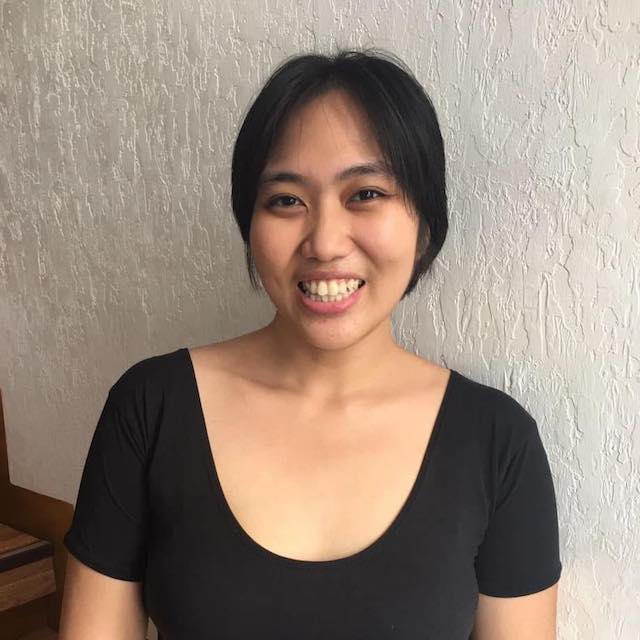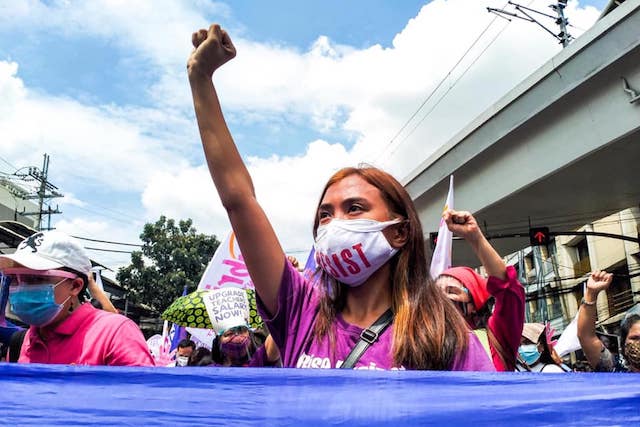What does the term “Filipina” mean to you?
In the age of identity politics, semantics seems to have taken up a big space in online tit-for-tats. However, there are folk who, while acknowledging the importance and inevitability of language evolving, warn that scrutinizing terms like Filipino/a/x might be a myopic way of progressing towards a more inclusive and just future.
For Women’s Month, we reflect on what it means to be a Filipina and the evolution of the local women’s movement with the help of a number of women’s advocacy groups and resource centers to look back on the campaign’s vibrant history and its enduring importance today.
We spoke to GABRIELA secretary-general Joms Salvador, Center for Women’s Resources’ (CWR) research and data bank officer Justine Siscar and UP Center for Women’s Studies’ (UPCWGS) senior research assistant Jasmine Cruz on the next steps we need to take and the more sustainable ways we can do to align ourselves with the movement’s goals.
Filipino is a gender-neutral word, but has it always been that way? Tell us how the term Filipina came to be.
Joms: I’m not a linguist, but I [will try to respond as] a perennial student of history and society. The use and acknowledgment of the term “Filipino” to refer to members of the Philippine nation, regardless of gender, is first and foremost a colonial construct. In Indigenous Tagalog language, the “o/a” gender distinction attached to nouns is not present. That distinction came about as our Indigenous language was Europeanized.
Justine: Since Spanish is a gendered language, “Filipina” was used as a female counterpart the same way natives were addressed as “indios and indias.”

Joms: If I may add, socially constructed gender distinction merely manifests in language. Gender(ed) social constructs of what a Filipina should be like were not always present in our pre-colonial history. We had, for example, women babaylans (religious and political leaders) who were not defined or limited by their gender characteristics. There’s also social evidence that rape and other forms of abuse and violence against women did not exist in some pre-colonial societies.
Jasmine: There’s also an interesting discussion now on the term “Filipinx.” Last September, UPCWGS and UP Babaylan hosted a webinar called “I am Filipinx: A Roundtable Discussion on the Emergence of Filipinx” [which you can still check out.]
Do you think it’s still important to embrace the word Filipina?
Justine: I think that the word Filipina can still be used as a symbolic recognition of the burdens and hardships Filipino women continue to face at present as well as a celebration of the many struggles we have overcome through the many roles we play as women: as young women, as mothers, as activists, as advocates, as scholars, as human rights defenders—as active players and agents for social change.
“The word ‘Filipina’ is just a collection of letters; what’s important is what we make out of being one.” – Joms Salvador
Joms: I really don’t see any reason why one shouldn’t. The word “Filipina” is just a collection of letters; what’s important is what we make out of being one. “Filipina” still connotes being part of this nation, being a woman, and aren’t those identities worth embracing? Besides, using another term for those identities does not easily equate to substantive change in the way Filipinas are treated in society. I am all for creating a society where every woman, every human being, is treated with respect and dignity—not shackled by destitution and oppression. That would be achieved by painstakingly working towards true equality and emancipation, and not by refusing to use existing words alone.
Justine: To borrow words from revolutionary and local women’s movement pioneer Ma. Lorena Barros in “Liberated Woman”: “The new woman, the new Filipina, is first and foremost a militant… The new Filipina is one who can stay whole days and nights with striking workers, learning from them the social realities which her bourgeois education has kept from her… More important this means she has convinced her parents of the seriousness of her commitment to the workers and peasants’ cause… a commitment which requires all sorts of behavior previously way beyond the bounds of respectable womanhood… She is a woman who has discovered the exalting realm of responsibility, a woman fully engaged in the making of history… No longer is she a woman-for-marriage, but more and more a woman-for-action.”
MANILA — GABRIELA leads thousands of women in the International Working Women’s Day march, demanding economic aid, wage relief, a COVID-free Philippines, and the ouster of President Duterte.
READ: https://t.co/DVFkotLIAB#IWD2021 #OustDuterte
(Photo credits: @ILPS_Phils) pic.twitter.com/Fi4hLP3GA7
— GABRIELA #LabanGabriela (@gabrielaphils) March 8, 2021
What’s an event or detail in the history of the local women’s movement that you think we should talk about more?
Justine: I believe that the country’s history is a history of people’s relentless resistance. Throughout history, women have been fighting alongside men as leaders and members of uprisings and revolutionary organizations, carrying out different tasks crucial in challenging foreign and local oppression. In closely studying the history of the local women’s movement, I think it is of utmost importance to recognize and commemorate the role of MAKIBAKA (Makabayang Kilusan ng Bagong Kababihan) as a national democratic organization forwarding the demands of women in the basic sectors and linking their struggles with the rest of the oppressed sectors in society.
During the revolutionary ferment in the ’60s, more and more young people were involved in understanding the root causes of oppression and structural poverty in the country. In the course of building organization and mounting mobilizations, progressive women recognized the need to form a group that specifically addresses women’s issues such as domestic struggles, violence and abuse, and commodification of women; issues that focus on the double burden experienced by women brought about by a feudal-patriarchal society. MAKIBAKA articulated the need for women to participate in the national democratic struggle to break free from women’s oppression. The organization was forced to go underground at the height of the Marcos dictatorship; eventually some members joined the armed resistance while many others continued discreet revolutionary work in urban centers. However, we cannot deny its relevance and importance to the local and international women’s movement today.
View this post on Instagram
Joms: I hope historians, academics and the whole of society would discuss more of the women’s movement itself than mere personalities, more of the ordinary people and the collective driving force behind the birthing of the vibrant women’s movement that we have in the Philippines, which remains to this day a model and inspiration to many social movements across the globe. There are the women peasants and indigenous communities that defended land and liberty from foreign interests; women from the working class and the intelligentsia that joined the struggle for national liberation; students and young women like Barros, members of MAKIBAKA and other youth organizations that rose against the Marcos dictatorship and walked in unity with the working class who bore the brunt of the crisis of that era. Historicizing women’s struggles would need more than just stress on individual “heroes” but an understanding of women’s collective struggle to liberate herself from the shared burden of her oppression.
What does the local women’s movement look like right now? What are the key issues being fought for?
Joms: I’d like to think that for the most part, we are still battling against the same forces of oppression as women and as people—patriarchy and feudalism, which serves as the social base of women’s oppression, and an economic system that allows and maintains the destitution of the majority, especially women who bear multiple social burdens and are historically the most marginalized in society. The current pandemic and intertwining general economic crisis we are experiencing only makes life even harder for many women.
Jasmine: To talk about the local women’s movement is a bit too challenging because it’s a bit too broad, [but I can share some of UPCWGS’ projects that aim to help tackle issues women face.]
Chikang Bayi is an accessible feminist podcast with episodes on misogyny and more. Angat Bayi trains women political leaders in feminist leadership. The Sexual Health and Empowerment (SHE) research project uses the arts to collect data on sexual and reproductive health rights and gender-based violence. Conversations Through Art is a series of workshops and talks on how creative modalities can be employed for social change. Lunas Collective is a chat service that aims to support survivors of gender-based violence and individuals with an emerging need for reproductive health advice. The Feminist Legal Network is a group of lawyers who are focused on gender-based violence and other women’s issues. The UPCWGS Research Grant seeks to fund cutting-edge research on women and gender in the Philippines and the ASEAN region. [We also help conduct] the Philippine Queer Studies Conference, the first national lesbian, gay, bisexual, transgender, queer, and intersex (LGBTQI) research conference in the Philippines.
UPCWGS’ Review of Women’s Studies Volume 30 and Review of Women’s Studies Volume 29.2: Special Issue on Gender and…
Posted by UP Center for Women’s and Gender Studies on Sunday, March 7, 2021
Justine: The local women’s movement has come a long way, and its successes are reflected in the many policies enacted such as the Magna Carta for Women, the Anti-Violence Against Women and Children Law, Expanded Maternity Leave Law and the Occupational Safety and Health Standards Law, among many others. These developments would not be possible without women tirelessly challenging the bounds set by society on them in different arenas, from the Congress to the streets, through their organizations and institutions. Moreover, a rising number of women’s organizations and institutions are built to provide services for fellow women in need.
At the height of the COVID-19 pandemic, women’s groups have led several initiatives to provide relief to those in need. In addition, women’s groups have continuously campaigned for mass testing, access to free and effective vaccines and affordable healthcare as well as demanded cash subsidies and wage increases for affected families—all these while the government continues to discredit and vilify the efforts of women’s organizations through relentless red-tagging and blatant violations of human rights.
Despite its many strides forward, however, the same contradictions in society remain. Landlessness, joblessness and increasing economic insecurity affect the majority of Filipino women. In 2021, the CWR estimates that at least 19.54 million Filipino women are economically insecure.
06 March 2021 | News Feature
Peasant women stand at the forefront for a self-sufficient future
If there is one…
Posted by CWR | Center for Women’s Resources on Saturday, March 6, 2021
Joms: [If we are to protect the victories we have won for women throughout the struggle and earn more victories ahead,] the women’s movement must inspire courage, concern for one another and collective action towards the betterment of society.
Any lesser-known recommendations for folk who are looking for accessible local resources and groups to learn about these issues from?
Joms: Never believe that social distancing negates social solidarity. Always find the time and develop a keen interest to discern fake news and black propaganda to know more about the real situation, issues and aspirations of women. There are various associations of women at every level of society to listen to, support and be in solidarity with. During this time when many are socially connected through the internet, maximize that venue to gain knowledge and inspiration.
Justine: As one of the pioneer research institutions for women in the country, we strive to provide timely and relevant resources on women’s conditions. [You may access] our website or send queries to our social media pages. CWR welcomes all individuals and organizations interested in learning about key issues concerning grassroots women.

Jasmine: If you are interested in the anti-sexual harassment movement in schools, [there are] different groups which emerged last year [that you can check out]. A number of them are ATE: Alliance of Theresians Ending HMARC, Hearters United Against HMARC, SPCP Square UP Alumni, Knollers for Knollers, ASHS Safe Spaces, AJHS Safe Spaces, Safe Spaces LHS Now, Mag-Aklas Raya, BOTtledUp, Protect Our Students! PH, Sulong, The Sanctuary Project–UPD, The Sanctuary Project, The Sanctuary Project PUP, Parisukatan, Malakas Coalition and STCQC Do Better.
Photo courtesy of GABRIELA
Follow Preen on Facebook, Instagram, Twitter, YouTube and Viber
Related Stories:
What if there were no cops? On a world without police and military forces
Meet Gantala Press, the feminist indie publisher fighting state violence
Is restorative justice the answer to ending rape culture?
Girl power or feminism? What’s the difference?


